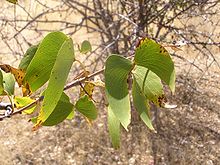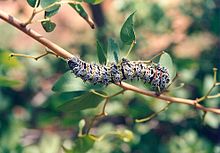Mopane
| Mopane | |
|---|---|

| |
| Scientific classification | |
| Kingdom: | |
| Division: | |
| Class: | |
| Order: | |
| Family: | |
| Subfamily: | |
| Tribe: | |
| Genus: | Colophospermum
|
| Species: | C. mopane
|
| Binomial name | |
| Colophospermum mopane | |
The mopane or mopani (Colophospermum mopane) tree grows in hot, dry, low-lying areas, 200 to 1,150 meters in elevation, in the far northern parts of southern Africa, into South Africa, Zimbabwe, Mozambique, Botswana, Zambia, Namibia, Angola and Malawi. The tree only occurs in Africa and is the only species in genus Colophospermum. The species name mopane is taken from the local name for the tree. The mopane is in the legume family (Fabaceae).

It is found growing in alkaline (high lime content) soils which are shallow and not well drained. It also grows in alluvial soils (soil deposited by rivers). In South Africa and adjacent areas of Botswana and Zimbabwe, the trees tend to vary between 4 and 18 m, often called mopane scrub but also sometimes taller and forming woodland, where further north the trees are taller and form tall woodlands referred to as cathedral mopane. This tree does not grow well outside hot, frost-free areas with summer rainfall.
Its distinctive butterfly-shaped leaf and thin, flimsy seed pod make it easy to identify. For human use it is, together with camel thorn and leadwood, one of the triad of definitive firewood trees. The name Colophospermum is Greek for "oily seed", in reference to the resinous seeds. The part of the name, colophos, apparently refers to the strong turpentine smell of the resin. Colophony is another name for rosin, a substance obtained from turpentine.
Uses

Mopane wood is one of southern Africa's heaviest timbers and is difficult to work because of its hardness.[citation needed] However, this also makes it termite resistant. For this reason it has long been used for building houses and fences, as railway sleepers and as pit props. The termite-resistance and rich, reddish colouring also make it popular for flooring. Outside Africa, mopane is gaining popularity as a heavy, decorative wood, its uses including aquarium ornaments, bases for lamps or sculptures, and garden accents.
It is also increasingly being used in the construction of musical instruments, particularly woodwind. Suitable quality African blackwood (Dalbergia melanoxylon), traditionally used for clarinets, is becoming harder to find. Mopane is fairly oily, seasons very well with few splits or shakes, and produces instruments of a warm, rich tone.[1]
Apart from timber, the tree is traditionally used to provide twigs to chew as tooth brushes, bark to make twine and for tanning, and leaves for healing wounds. The wood is also used to make charcoal and for braai wood.
The tree is a major food source for the mopane worm, the caterpillar of the moth Imbrasia belina. The caterpillars are rich in protein and are eaten by people, and the sale of roasted or dried mopane worms can contribute significantly to rural economies. The tree also acts as a foodplant for a wild silk moth, Gonometa rufobrunnea. Cocoons of the moth are harvested as wild silk, to make cloth.
The mopane tree also serves as a host plant for the mopane psyllid Retroacizzia mopani.[2][3]
See also
References
- ^ Prosono International Woods for woodwinds. Retrieved 23 April 2010.
- ^ Oppong, C.K., Addo-Bediako, A., Potgieter, M.J. & Wessels, D.C.J. 2009. Distribution of the eggs of the mopane psyllid Retroacizzia mopani (Hemiptera: Psyllidae) on the mopane tree. African Invertebrates 50 (1): 185-190. [1]
- ^ Oppong, C.K., Addo-Bediako, A., Potgieter, M.J. & Wessels, D.C.J. 2010. Nymphal behaviour and lerp construction in the mopane psyllid Retroacizzia mopani (Hemiptera: Psyllidae). African Invertebrates 51 (1): 201-205.[2]
- Esterhuyse, N., Von Breitenbach, J. & Söhnge, H. 2001. Remarkable trees of South Africa. Briza Publications, Pretoria.
- Ferwerda, J.G. (2005) Charting the quality of forage: measuring and mapping the variation of chemical components in foliage with hyperspectral remote sensing. Wageningen, Wageningen University, 2005. ITC Dissertation 126, 166 p. ISBN 90-8504-209-7.
